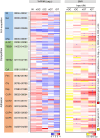Oral pathobiont Klebsiella chaperon usher pili provide site-specific adaptation for the inflamed gut mucosa
- PMID: 38545880
- PMCID: PMC10984132
- DOI: 10.1080/19490976.2024.2333463
Oral pathobiont Klebsiella chaperon usher pili provide site-specific adaptation for the inflamed gut mucosa
Abstract
The ectopic gut colonization by orally derived pathobionts has been implicated in the pathogenesis of various gastrointestinal diseases, including inflammatory bowel disease (IBD). For example, gut colonization by orally derived Klebsiella spp. has been linked to IBD in mice and humans. However, the mechanisms whereby oral pathobionts colonize extra-oral niches, such as the gut mucosa, remain largely unknown. Here, we performed a high-density transposon (Tn) screening to identify genes required for the adaptation of an oral Klebsiella strain to different mucosal sites - the oral and gut mucosae - at the steady state and during inflammation. We find that K. aerogenes, an oral pathobiont associated with both oral and gut inflammation in mice, harbors a newly identified genomic locus named "locus of colonization in the inflamed gut (LIG)" that encodes genes related to iron acquisition (Sit and Chu) and host adhesion (chaperon usher pili [CUP] system). The LIG locus is highly conserved among K. aerogenes strains, and these genes are also present in several other Klebsiella species. The Tn screening revealed that the LIG locus is required for the adaptation of K. aerogenes in its ectopic niche. In particular, we determined K. aerogenes employs a CUP system (CUP1) present in the LIG locus for colonization in the inflamed gut, but not in the oral mucosa. Thus, oral pathobionts likely exploit distinct adaptation mechanisms in their ectopically colonized intestinal niche compared to their native niche.
Keywords: Chaperon usher pili; Klebsiella; gut microbiota; inflammatory bowel disease; oral microbiota; pathobionts; periodontitis.
Conflict of interest statement
The authors declare that the research was conducted without any commercial or financial relationships that could be construed as a potential conflict of interest
Figures





References
-
- Escapa IF, Chen T, Huang Y, Gajare P, Dewhirst FE, Lemon KP, Xu J.. New insights into human nostril microbiome from the expanded human oral microbiome database (eHOMD): a resource for the microbiome of the human aerodigestive tract. mSystems. 2018;3(6). doi:10.1128/mSystems.00187-18. - DOI - PMC - PubMed
Publication types
MeSH terms
Grants and funding
LinkOut - more resources
Full Text Sources
Molecular Biology Databases
Miscellaneous
